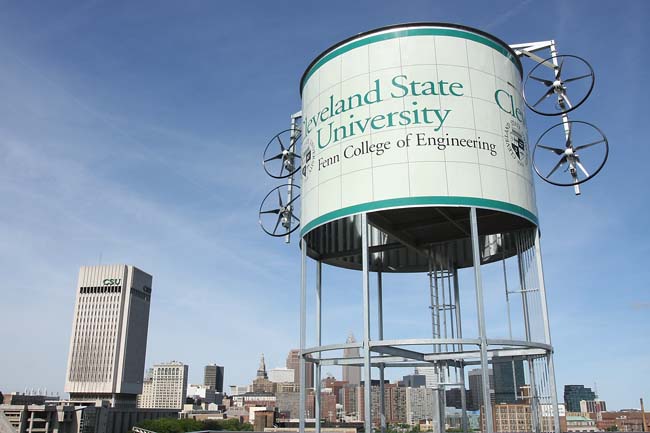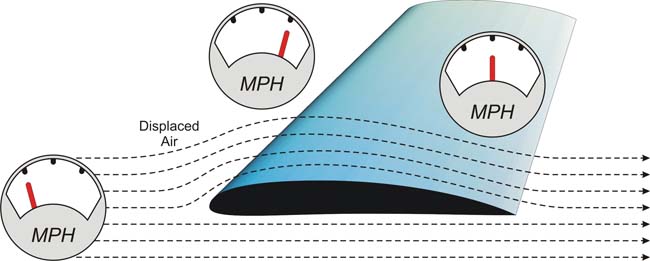CAD and Rapid Tech Take Us Toward the Windy City
Dr. Majid Rashidi has designed an economical way to squeeze more power out of less wind by windspeed amplification.
Latest News
January 1, 2011
By Mike Hudspeth, IDSA
Just about everything we use, enjoy or depend upon is electric—a situation that continues to grow more problematic. From rolling brownouts in California to complete blackouts in the northeast, we are continually seeing that we need to find new ways of meeting our electrical needs.
 Dr. Rashidi’s turbines can be retrofitted to such structures as water towers and grain silos. He believes there are plenty of round structures that would be ideal places to generate electricity. |
Today, we generate power in many ways. We burn coal, but clean it all you want—it still pollutes (and is dangerous to dig). We build hydroelectric dams that use the potential energy of water concentrated by gravity to turn turbines downstream, but they submerge and destroy a lot of natural habitat. We split the atom in nuclear power plants, but few people want one in their back yards.
In the alternative energy corner, we have solar power. Solar cells are cleaner and are getting more efficient all the time, but still lag far behind most traditional forms of energy generation. We are building giant wind farms, but many people think they are eyesores, loud and dangerous for wildlife. We are even starting to use waves and the tides to generate energy.
We are trying, but how are we going to get the job done?
Enter Dr. Majid Rashidi. He has designed a new kind of wind tower that could help make a difference between convenience and doing without.
 When a constant flow of air encounters a wing, it changes direction and flows around it. The design of an airplane wing increases the surface area on the top side of the wing more than the bottom side. The air must go faster, thus creating lift. |
| DFM Basics Design for manufacturing (DFM) is a discipline that pays careful attention, from the earliest stages of a project, to how something is made. It looks to simplify the process and make it easier. There are lots of examples of how this is done: snaps instead of screws and labor (automated or human) to screw them in, assembly part reduction, materials specification, etc. It all adds up. |
How It Works
A wind tower introduces a propeller into an air flow. The wind pushes against the propeller’s surfaces, causing it to turn, which rotates a turbine (essentially a motor) that generates electricity by passing magnets near conductive coils, thus inducing electron flow, or current.
There are usually two problems at this point:
1. Rotational motion is transmitted through a gearbox to the turbine, an inherently inefficient process.
2. It takes a lot of wind to rotate the propellers. Even the best turbines don’t operate near their theoretical limits.
Friction is the enemy of efficiency. Bearings aren’t perfect. They drag on the turbine, slowing it down. Even the magnetic field inside the turbine does all it can to stop the rotation. Air is a relatively low-density energy source, and even when propellers get going there is what is called a “cut-in speed”—the speed the propellers have to rotate before they can even begin to generate usable electricity.
Rashidi developed a wind tower that can operate in much lighter winds. Not only that, but it is considered to be much safer than existing wind towers. It doesn’t use huge propellers, instead employing multiple smaller ones.
Rashidi is a professor at the Fenn College of Engineering at Cleveland State University in Ohio. His expertise is in machine system design, machine component design, design for manufacturing (DFM), dynamics/vibrations of machinery, fluid-solid interactions in machinery, and bearing design.
Air is basically a fluid. It ebbs and flows, following the path of least resistance. When forced against an obstacle, it will displace or flow around the object. Any time there is a change in direction, relative velocity increases. This is how a wing generates lift. The ambient air velocity increases as the air goes over the wing, but must equalize by the time it flows off the back of the wing.
Rashidi capitalizes on this principle by mounting a column of turbines on a rotating base on each side of a cylindrical structure. When the wind encounters the cylinder, it flows around it, picking up speed. The turbines are located to either side, right in the path of the flowing air where it’s going its fastest. Testing has indicated that efficiencies of up to 60% are possible—much higher than most wind tower designs. And because of the rotating base, the wind can come from any direction.
Developmental Details
Rashidi fleshed out designs he hopes will spread across the globe.
“It’s not the initial idea that I patented,” he says; rather, it’s the result of tinkering and shaping the model into a feasible product. Using DFM principles, Rashidi modified and streamlined the wind tower, making it more cost-effective.
| Wind Tower Costs The short answer is that it depends on how it’s put together. When piecing together the prototype for Cleveland State University’s roof, Dr. Majid Rashidi was constrained to go through certain channels to acquire parts. The turbines for his system came in at about $10,000 apiece. Obviously, though, these units can be had much cheaper. In fact, he notes that any secondhand electric motor or junkyard automotive alternator could be made to do the same thing. Using materials of this kind, then, would enable anyone’s budget to build one of Rashidi’s wind towers. |
“I used SolidWorks’ design software for generating the engineering drawings of the project,” Rashidi explains. “I also used Fluent software for computational fluid dynamics (CFD) analysis to simulate the air flow patterns for my system.”
Rashidi is quick to note that although that was the software he used, equivalent results would have been realized with other products. “The above tools made it possible for us to optimally design the system and minimized the fabrication trial-and-error that we would have otherwise encountered,” he says.
Rashidi used a Z Corp. rapid prototyping machine to develop tabletop,scaled-down inkjet 3D printed composite resin models of the system, and tested the main design concept in small scale.
Plan of Action
Rashidi’s prototype wind tower graces the roof at Cleveland State University, and he says there are places in the heart of just about every city where the wind tower could be installed. Because the propellers are much smaller than traditional wind towers, it will fit on existing structures like water towers.
By using energy that is available at night, when demand is lightest, water can be pumped up into towers. Later, that water can be released and the flow used to turn turbines. Thus, a water tower becomes a sort of “hydro-gravitic battery,” capturing and using the potential energy of the elevated water. Rashidi also notes that the wind tower can even be placed on a grain silo to help power a farm.
More Info:
ANSYS
Dassault Systèmes SolidWorks
Z Corp.
Mike Hudspeth, IDSA, is an industrial designer, illustrator, and author who has been using CAD and design products for more than 20 years. He is DE’s expert in ID, design, rapid prototyping, and surfacing and solid modeling. Contact him via [email protected].
Subscribe to our FREE magazine, FREE email newsletters or both!
Latest News
About the Author
DE’s editors contribute news and new product announcements to Digital Engineering.
Press releases may be sent to them via [email protected].






